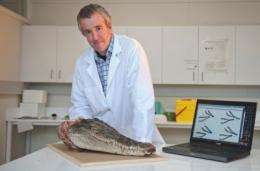Link between shape of crocodile's lower jaw and diet examined

(Phys.org)—Researchers have shown how the shape of a crocodile's snout could determine its ability to feast on certain types of prey, from large mammals to small fish.
Led by Dr Colin McHenry and PhD student Chris Walmsley, from Monash University's School of Biomedical Sciences, a team of researchers compared the jaw strength of different types of crocodiles when feeding on large prey. Using computer technology they subjected the jaws to the sorts of biting, shaking, and twisting loads that crocodiles use to feed on large prey. The team generated 3D images showing the strain measured on the jaws of seven diverse species of crocodile.
They found the lower jaws of short-snouted crocodiles performed well under the loads applied to mimic the feeding behaviour on large prey, but those with elongated jaws were more likely to break under the same loads, showing their limited ability to feed on large prey.
Detailed today in PLoS One, the findings contribute to the understanding of how the shape of the crocodile's skull correlates with strength. It is the first study of its kind to investigate the mechanics that underlie the link between the shape of the lower jaw and diet.
"The notion that long, narrow snouted crocodiles feed primarily on fish or small prey is well established, but the biomechanics of the crocodiles' lower jaw, the mandible, have not been previously explored," Mr Walmsley said.
"To test the jaw biomechanics of large crocodiles we used a computational engineering approach, called Finite Element Analysis, that is widely used to design planes, cars, boats, buildings, bridges and many other structures.
"We found that mandible shape correlated consistently with jaw biomechanics. This means that the lower jaws of long-snouted species were not as strong and more likely to break during feeding on large prey. It's therefore no surprise that they tend to concentrate on small, agile, aquatic prey whilst shorter and more robust-snouted animals are capable of taking much larger prey."
Dr McHenry said the findings were relevant to a broad range of aquatic predators including dolphins and fossil marine reptiles.
"Interestingly the amount of strain a jaw was under was directly proportional to the length of the symphysis, which is the joint between two halves of the lower jaw. This means the animal's biomechanical response to force could be accurately predicted by knowing the length of its chin.
"Killer whales, alligators and salt-water crocodiles can all feed on large prey. In all of these species the symphysis is a small proportion of the length of the jaw. Whereas, fish-eating crocodiles and dolphins have long, narrow chins."
Dr McHenry said further research was needed to explain why crocodiles that feed on small prey had elongated snouts.
"We suspect the answer lies in the hydrodynamic efficiency of the elongate jaws, and we plan to explore this further using other computational engineering techniques," Dr McHenry said.
More information: www.plosone.org/article/info%3Adoi%2F10.1371%2Fjournal.pone.0053873
Journal information: PLoS ONE
Provided by Monash University



















